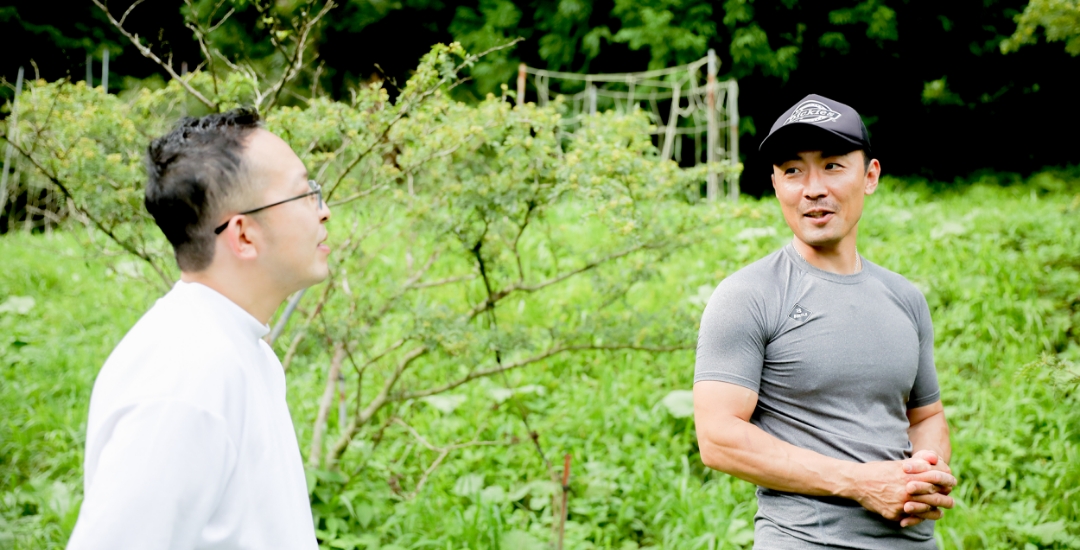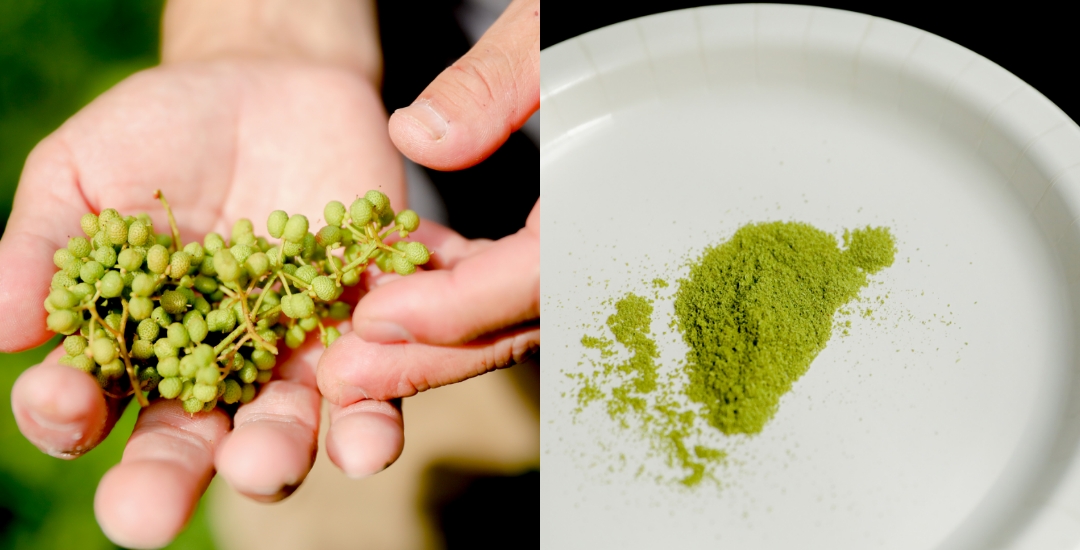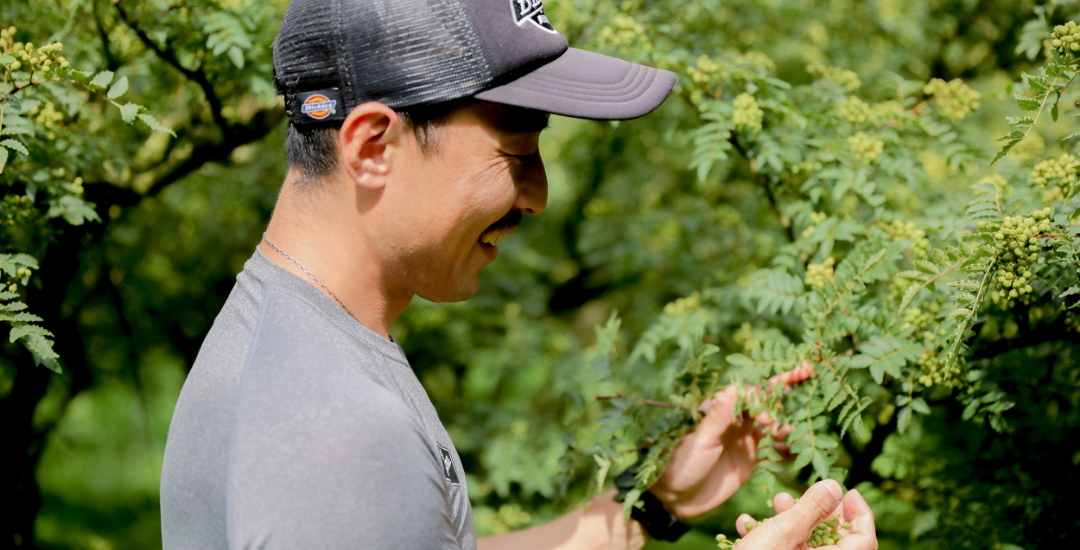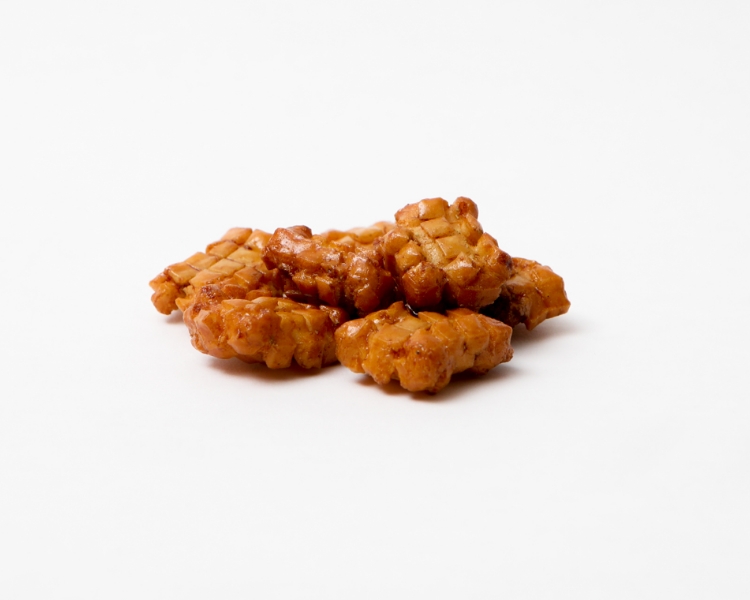Cultivating the Region’s Traditional Sanshō Pepper in the Land Blessed by Kōbō-Daishi
Kitora Farm is located on a slope in the mountains, 600 meters above sea level. In 2011, upon his marriage, Mr. Shinda moved back to his hometown in Wakayama prefecture and started growing sanshō here. The old name for this area was “祈祷田 Kitouda (Prayer Field)”, from the legend that Kōbō-Daishi cultivated these fields while praying; over the course of time this evolved to the name “北浦 Kitora”.
In addition to this legend, this area is also famous as the very place where Budō sanshō was first discovered at the end of the Edo period. Since Budō sanshō has a more powerful aroma and pungency than ordinary sanshō, its cultivation soon spread throughout the entire Aritagawa area.
We visited the farm in July, when the sanshō trees were lined with fresh green fruits. The trees were very carefully pruned so that the branches spread out horizontally, for easy harvesting. When you try a freshly picked green berry, you are immediately surprised at not only the spicy aromatic taste but also the intense and refreshing sensation.
「I was living as a part-time worker in Nagoya and Tokyo until I started my farm at the age of 29. A relative of mine who happened to be a local sanshō farmer recommended me to try sanshō farming, and without much thought I decided to give it a go. Five or six years before returning to my hometown, I started searching and purchasing land, planted young trees, and made preparations, but then the price of sanshō crashed. So it was very difficult in the beginning.」

Growing & Production: More than Just Farming
There was a time when Budō sanshō was traded at a good price as a local specialty of Aritagawa and everyone was planting sanshō trees. However, in the first half of the 2000s overproduction saturated the market and the price collapsed. This, compounded by an aging farming population, resulted in many farmers retiring or stopping production of sanshō.
「There are about 200 sanshō pepper farmers in the town, and the average age now is 80. So those who were hit by the price collapse at the time have either quit or are just trying to make a little extra money while receiving a pension… At the time I started farming, I don’t think anyone was making a living from sanshō farming.」
After encountering unexpected hardships early in his farming career, Mr. Shinda decided to supplement his income by growing and producing mulberry leaf tea in the off-season for sanshō farming. And, for the past five years Mr. Shinda has also been engaged in the government assisted “6th Industrialisation”; where farmers are encouraged to not only grow their crops, but also to process their harvest for market, and be responsible for distribution and sales; which Mr. Shinda does under the “Kitora Farm” brand.
「We use small electric millstones to grind the dried berries into a powder, which we sell at roadside stations and on the internet. I thought that because I am a farmer, I could distribute really good quality products to the market myself. It was a significant change for us to be able to obtain direct feedback on our products after we started expanding what we do on our farm. It is a pleasure to know how our products are being used and how people are enjoying them. We are only able to process about 10% of our total harvest at this moment, but we hope to increase that percentage in the future.」
Processing the harvested berries, including removing the seeds, and drying and grinding the peel, is still done by hand on a small scale. It is time-consuming, but the results are worth it. Mr. Shinda’s beautiful bright-green sanshō gives an intense and refreshing sensation; surprising you not only with its spiciness but also with its delicate aftertaste.
「This bright green color is a sign of good quality. I think this quality is hard to obtain unless it is produced directly by the farmer. It is delicious on steaks and fried chicken, especially when seasoned with salt.」
 Freshly harvested sanshō pepper (left) and ground sanshō pepper that retains its bright green color (right)
Freshly harvested sanshō pepper (left) and ground sanshō pepper that retains its bright green color (right)Unique Flavors Attracting the Attention of Chefs Worldwide
Ironically, the production of Budō sanshō, once in excess, has plummeted; now production cannot keep up with demand. Since the sanshō tree produces fruit for only a relatively short period of time of about 30 years, it is necessary to plan and plant young trees in advance but this too is not going well in the town.
「I am seriously concerned about what will happen five years from now if we don’t do something about it.」
On the other hand, in recent years, the distinctive charms of sanshō have become appreciated overseas and Mr. Shinda can see new possibilities for the future of sanshō. The experience of introducing Japanese pepper to top chefs in Europe, at an event that he attended in France a couple of years ago, was a great source of inspiration.
「I learned the idea of combining powdered sanshō with dairy products such as fresh cream and cheese, as well as with chocolate. Recently, I’ve heard that some restaurants have been adding powdered sanshō to craft beer and whisky with soda.」
The sanshō tree has been rooted in Japanese culture since ancient times. Its flowers, leaves, and fruits are used as herbal medicines and spices, and the wood is used to make surikogi (pestles); this is a plant where nothing is left to waste. Together with the sanshō producers, we at Narumi-ya would like to share this delightful delicacy, so loved by the Japanese, with as many people as possible… and this trip to Wakayama has renewed our commitment to do so.







